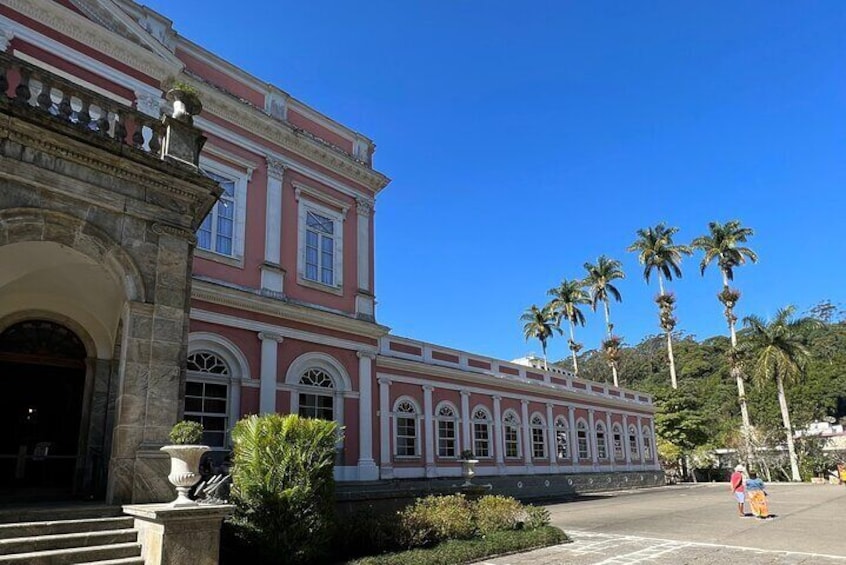
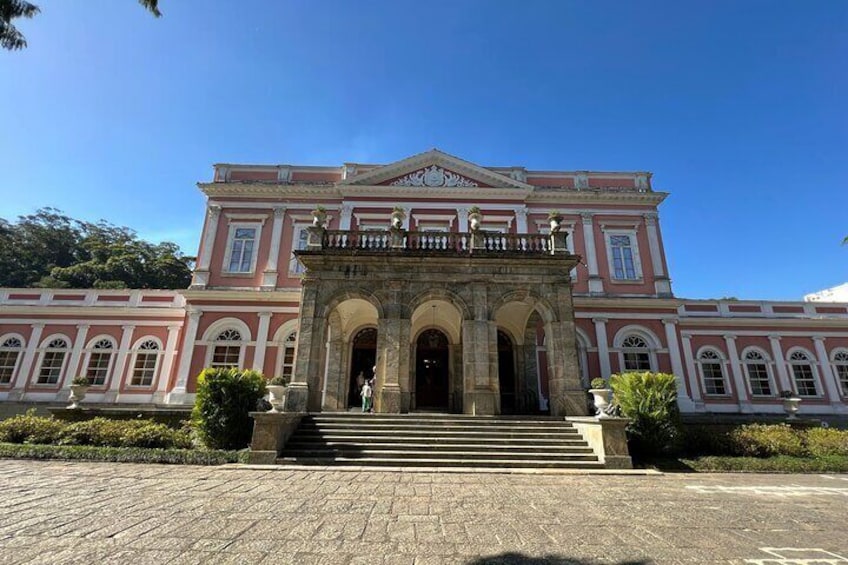
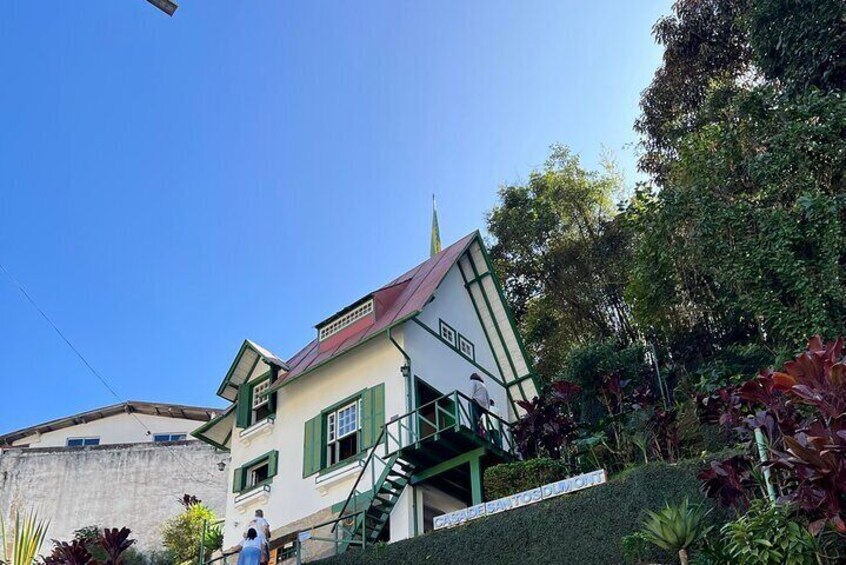
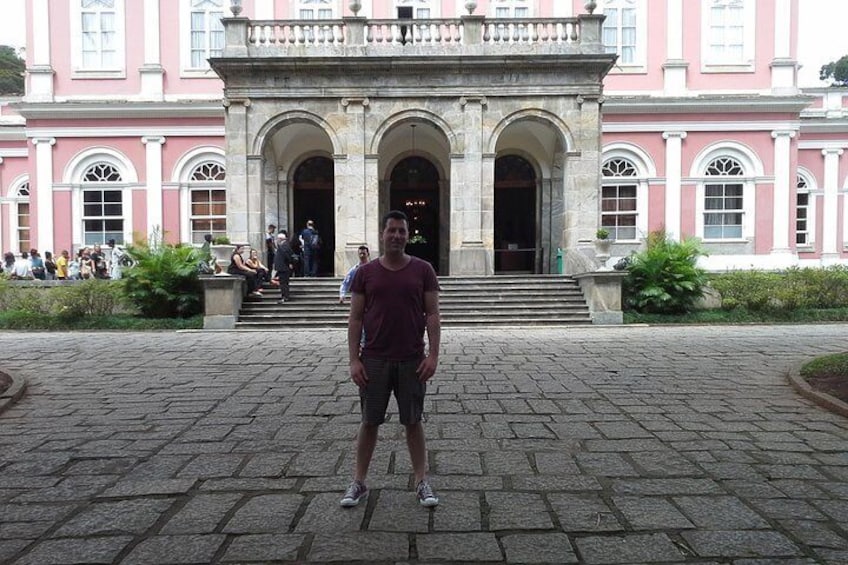
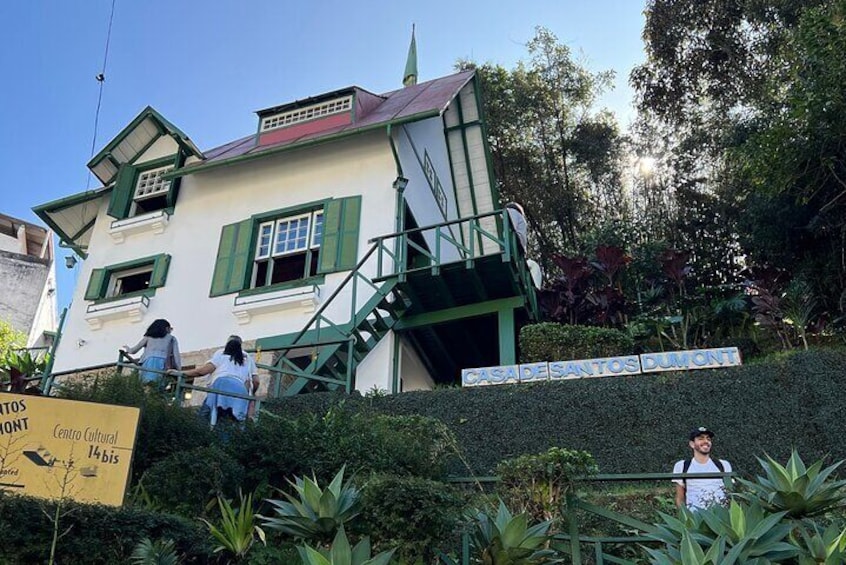
Private Petrópolis -Imperial Museum,dummont house,Cristal Palace,S.Pedro Church
By Trip In Rio
5/5
5 out of 5Free cancellation available
per adult*
*Get a lower price by selecting multiple adult tickets
Features
- Free cancellation available
- 10h
- Mobile voucher
- Instant confirmation
- Selective hotel pickup
- Multiple languages
Overview
Get to know the history and beauty of Petropolis with transport and professional guide with all the necessary information for your entertainment and culture.
With the royal family residing in Rio de Janeiro, many trips were made crossing the interior of the present state of RJ, In one of these voyages made by Dom Pedro I in 1822, which travelled from Rio de Janeiro to the Golden Path in Minas Gerais, the emperor lodged at the Padre Correia farm in the region. The enchantment was immediate, and there began a love storey between Dom Pedro I and the region of Petropolis, which shortly afterwards acquired the then Fazenda do Córrego Seco, which would be called “Petropolis.“.
Activity location
- Catedral de Sao Pedro de Alcantara
- Rua Sao Pedro Alcantara 60,
- 25685-300, Petropolis, State of Rio de Janeiro, Brazil
Meeting/Redemption Point
- Catedral de Sao Pedro de Alcantara
- Rua Sao Pedro Alcantara 60,
- 25685-300, Petropolis, State of Rio de Janeiro, Brazil
Check availability
Private Petrópolis -Imperial Museum,dummont house,Cristal Palace,S.Pedro Church
- 10h
- English
Pickup included
Starting time: 8:00am
Price details
CA $328.60 x 1 AdultCA $328.60
Total
* Select 4 adult tickets to get our lowest price of CA $104.06 per adult
What's included, what's not
- Professional informations and tour guide w/car
- Tickets for the museum
- Air-conditioned vehicle
- Lunch
- Tickets for cervejaria Bohemia (It is optional the visit)
- Tickets for Dummont house
- Tickets for Bohemia cervejaria (optional visit)
- Tickets Quintandinha Palace
Know before you book
- Infants are required to sit on an adult’s lap
- Suitable for all physical fitness levels
Activity itinerary
Catedral de Sao Pedro de Alcantara
- 30m
Originally, the Mother Church of Petrópolis was a modest building located in front of the Imperial Palace, but the construction of a new Matrix was already foreseen, in the present place, in the urbanisation plan of Petrópolis, dated 1843, written by Major Júlio Frederico Koeler.
Facade of the cathedral.
In the 1870s the construction of the new church was reconsidered, thanks to the interest of Dom Pedro II and his daughter, Princess Isabel. In 1871 the construction of a new Matrix was officially decided, but it would take time to materialise. In 1876 the Italian architect Federico Roncetti presented / displayed a project in neo-Renaissance style, that was refused.
The current building of the cathedral began to be built only in 1884. The project was commissioned from the Bahian engineer and architect Francisco Caminhoá, who conceived a neo-Gothic style building, very fashionable at the time, especially inspired by the old cathedrals of northern France. The work was carried out by Manuel Pereira Jerônimo's contractor, the son of one of the first families to settle in the city, from Pico Island in the Azores.
The construction of the cathedral did not stop after the Proclamation of the Republic and followed until 1901, when the works enter a period of paralysis. Under the command of engineer Heitor da Silva Costa, the work entered a second phase of intense activity in 1918. Finally, on November 29, 1925, the new headquarters of Petrópolis was inaugurated after 37 years of work. The building, however, was not finished, lacking the main façade and the tower, and much of the interior decoration. The works of the facade only began in 1929 and reached rosette level in the 1930s. The tower would only be built between 1960 and 1969. Interior of the Cathedral.
In 1920 the decree banning the Imperial Family of Brazil was annulled, and as early as 1921 the remains of Dom Pedro II and D. Tereza Cristina were brought from the Monastery of São Vicente de Fora, in Lisbon, to Rio de Janeiro, where were housed in the Metropolitan Cathedral. In 1925 the remains were transferred to the sacristy of the cathedral of Petropolis. Finally, on December 5, 1939, President Getúlio Vargas and other authorities inaugurated the Imperial Mausoleum, where the Emperor and Empress were finally transferred. In 1971, Princess Isabel and her husband, Count D'Eu were buried in the mausoleum.
Museu Casa de Santos Dumont
- 1h
- Admission ticket included
in the state of Rio de Janeiro, Brazil.
The house of Santos Dumont in Petrópolis is a picturesque residence embedded in a steep locality in the city. Santos Dumont received the invitation to summer in Petrópolis of Princess Isabel, during the golden season of the city during the Empire, and when accepting the invitation decided to build a house that would meet their needs.
The street chosen today is called Rua do Encanto and in Petrópolis, the house was nicknamed "A Encantada".
The house has some peculiarities, like one of its last inventions that is the shower with hot water, the only one of Brazil at that time, being heated to alcohol, and also the external staircase where one can only start to climb with the right leg, and the internal that can only be raised with the left leg, and the very architecture of the house where no partitions are used between the rooms.
The house has three floors, plus an observatory, over the roof.
Cervejaria Bohemia
- 1h
- Admission ticket not included
It was founded in 1853 in the city of Petrópolis, state of Rio de Janeiro, by the German settler Henrique Kremer, then artist with the name of Bohemia brewery. When he died in 1865, the company was left with his heirs, who renamed it Augusto Kremer & Co.. Shortly after a decade with the separation of the partners, the company was in charge of Frederico Guilherme Lindscheid. At the time of its foundation, Bohemia preserved the characteristics of the German beers of the time, with an initial production of six thousand bottles per month. The product was distributed through wagons, cars pulled by animals etc., and sales were made directly. Later, sales were made through dealers in the region of Petrópolis, a mountain region of the state of Rio de Janeiro. Over time, the bitter and strong characteristics of the German beers were being altered to conform to the market of the time and with the competing brands, and the flavour became lighter and less bitter, reaching the point of how it is sold today. With the control in the hands of Frederico, the company changed its name to Imperial Fábrica de Cerveja Nacional and, with his death in 1898, his daughter who was married to Herique Kremer Jr., the grandson of the founder of the company, created the Companhia Cervejaria Bohemia.
In 1960 the company was bought by Companhia Antarctica Paulista, with production at the time of ten thousand dozen per month. Currently part of AmBev.
In 2002, dark bohemia, Schwarzbier type beer, was launched using rare malts imported from Munich. The difference is a unique colour, a special, softer, more inviting flavour and a velvety, full-bodied, creamy froth.
In 2003, the Bohemia Weiss was launched. It was also launched the bohemia royall ale, a beer with English recipe, high fermentation and high alcohol content (6%), which results in a strong and strong flavour.
In 2005, it was launched the bohemian confraternity, an abbey beer.
In 2012, Bohemia reopens the Petrópolis factory remodeled and functioning as a kind of museum and beer memorial, with games and equipment that participant interacts with the factory and shares in their social networks.
Crystal Palace
- 45m
The pre-assembled structure was commissioned by the Count d'Eu, being built in the workshops of the Saint-Souver Lés Arras Corporation in France. The structure is inspired by the Crystal Palace in London, and the Crystal Palace of Oporto.
The Count's intention was to give Princess Isabel to cultivate her vegetables.
In 1938, the Palace was covered with tin sheets and bricks to house the Historical Museum of Petropolis, which would later be transferred to where the Imperial Museum of Petropolis now operates.
In 1967 the palace was dropped by the National Historical and Artistic Heritage Institute, but it remained covered. Walls similar to the original ones were placed in the year of the celebration of the centenary of the palace, in 1984.
The Crystal Palace is used for exhibitions and events, such as the Bauernfest, annual feast in honour of the German settlers of Petropolis. Today the palace walls are covered in glass, and as seen above works for historical events.
Imperial Museum
- 2h
- Admission ticket included
In 1822, Dom Pedro I, travelling to Vila Rica, Minas Gerais, to seek support for the movement of the Independence of Brazil, was enchanted with the Atlantic Forest and the mild climate of the mountain region. He stayed at Fazenda do Padre Correia and even made an offer to buy it. Faced with the owner's refusal, Dom Pedro bought the Fazenda do Córrego Seco in 1830 for 20 contos de reis, thinking of transforming it one day into the Palace of Concordia.
The successive political crisis in Portugal and the internal dissatisfaction were decisive for his return to the native land, where he would die without returning to Brazil. The Fazenda do Córrego Seco was left as an inheritance for his son, Dom Pedro II, who would build his favourite summer residence there. At the behest of Dom Pedro, the beautiful neoclassical building was constructed, where the Imperial Museum now operates, which began in 1845 and was completed in 1862. To begin construction, Pedro II signed a decree on March 16, 1843, creating Petropolis. A large number of European immigrants, mainly Germans, under the command of the engineer and superintendent of the Imperial Treasury, major Julius Friedrich Koeler, was in charge of raising the city, building the palace and colonising the region.
Constructed with resources from the emperor's personal endowment, the building had the original design elaborated by Koeler himself and, after his death, was modified by Cristoforo Bonini, who added the granite portico to the central body. To conclude the work, important architects connected to the Imperial Academy of Fine Arts were hired: Joaquim Cândido Guillobel and José Maria Jacinto Rebelo, with the collaboration of Manuel de Araújo Porto Alegre in decoration.
The complex was enriched, still in the 1850s, with the garden planned and executed by the landscaper Jean-Baptiste Binot, under the guidance of the young emperor. The vestibule floor, in Carrara marble and black marble from Belgium, was laid in 1854, and the floors and frames made of hardwoods, such as jacaranda, cedar, pau-satin, pink and vigna, from the various provinces of the Empire.
Quitandinha Palace Congress and Convention Center
- 1h
- Admission ticket included
his Norman style is characteristic of European casinos that were successful in Normandy before World War II, and the interior recalls scenarios of American films, hence the style in Brazil. The environments were decorated by Doroth Draper, set designer of Hollywood's famous films.
In an area of 50,000m2, Quitandinha was built to be the "Game Capital Bank in Brazil". Marble bathrooms, chandeliers with crystal pendants and a lighting system that would be enough to illuminate a city of 60,000 inhabitants. Its halls can house up to 10,000 people simultaneously.
The summit of the Mauá Hall is the largest in the world, 30m high and 50m in diameter, compared to the bell tower of St. Peter's Cathedral in Rome; the Teatro Mecanizado with three rotating stages has a capacity for 2,000 people. The lake is shaped like the map of Brazil with the lighthouse on the island of Marajó.
Guests at Hotel Quitandinha were millionaires, actresses, vedetes, politicians who wanted to get the most out of living well. On May 30, 1946, the Pres. Dutra banned the game in the country and thus, Quitandinha ended up not being able to survive as a hotel, its apartments were little by little being sold and from January 1989 was restored and currently the social part is used for congresses, events, shows and fairs .
Location
Activity location
- Catedral de Sao Pedro de Alcantara
- Rua Sao Pedro Alcantara 60,
- 25685-300, Petropolis, State of Rio de Janeiro, Brazil
Meeting/Redemption Point
- Catedral de Sao Pedro de Alcantara
- Rua Sao Pedro Alcantara 60,
- 25685-300, Petropolis, State of Rio de Janeiro, Brazil
Best Deals on Things to Do
Experience the wonders of the world up close with great deals on things to do near and far. We offer one-of-a-kind activities that allow you to explore Petropolis your way. Whether you love nature, culture, food, or a bit of adventure, we have the perfect activity for you.